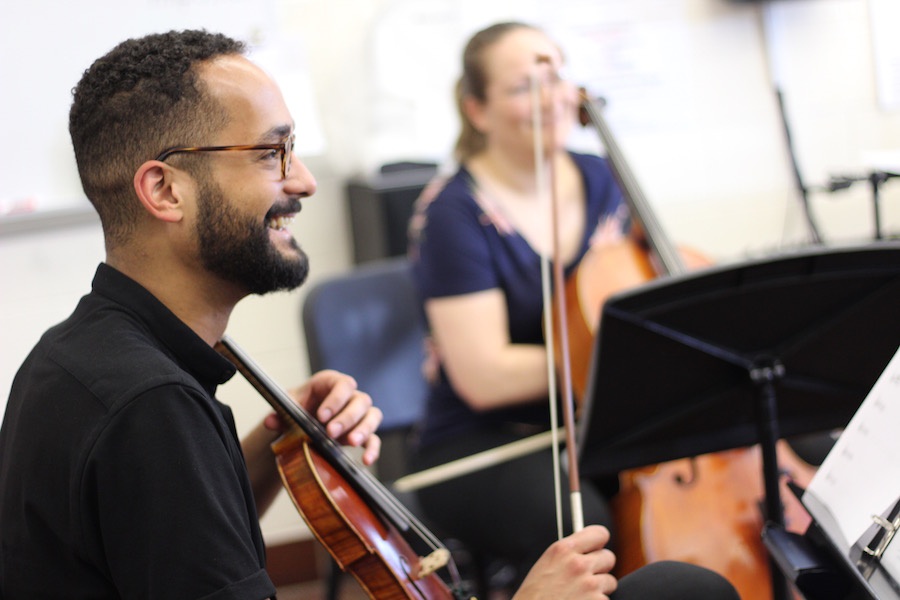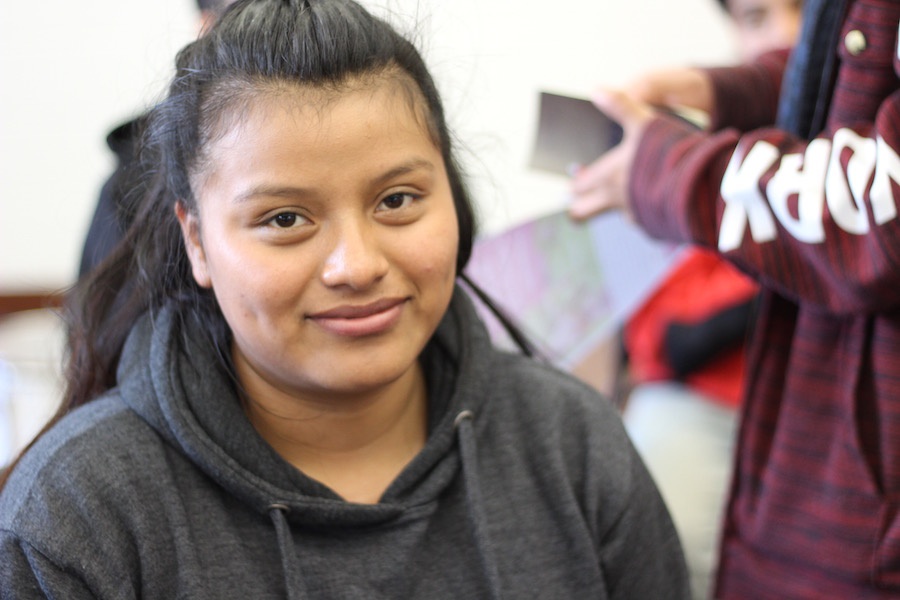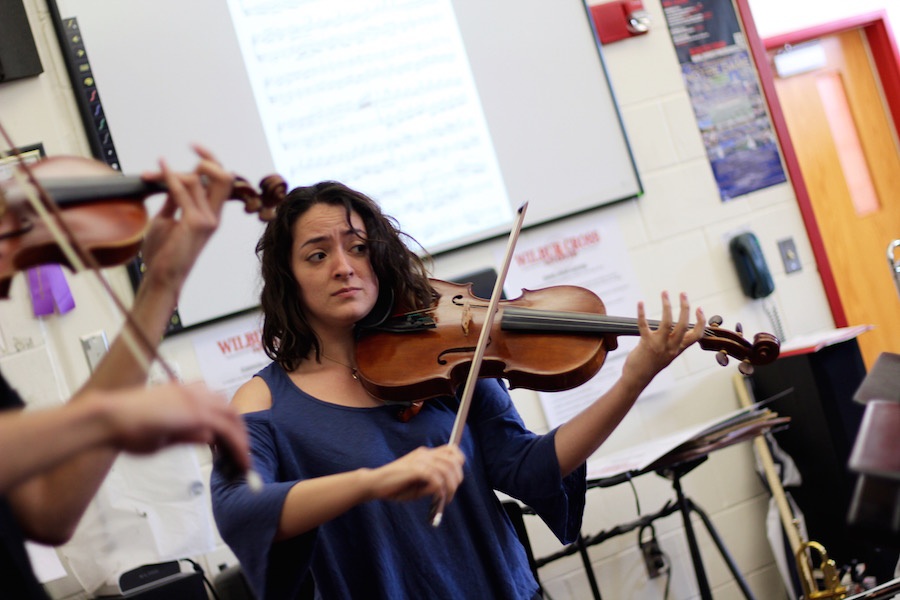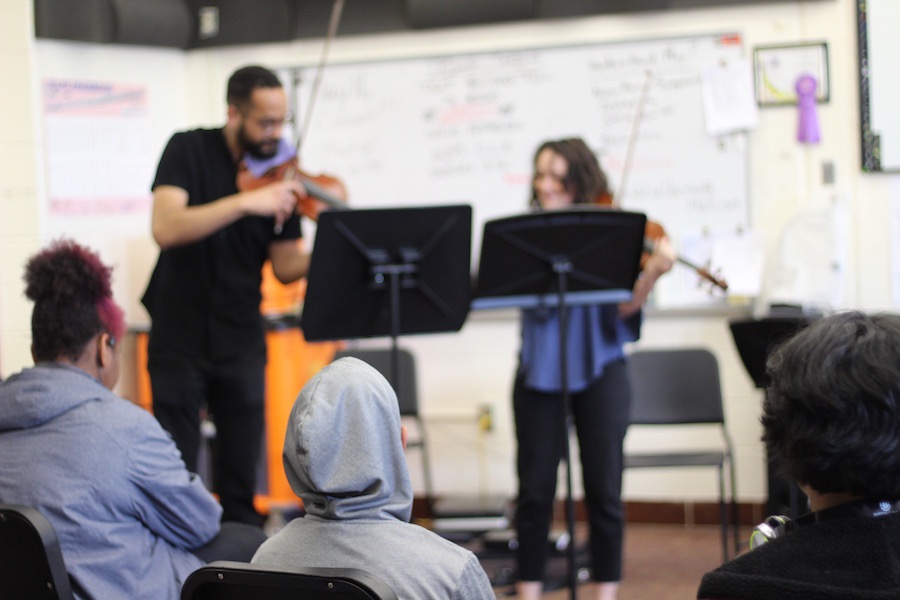James Keene, Becky Patterson and Gabrielle Skinner were rounding the end of Martha Chilel Velasquez’ “Innovation.” A violin sang out, riding a sort of wave as it coasted up, and then fell gracefully downward. Cello and viola unraveled under it, then stopped. The room burst into polite applause.
Keene focused on the piece’s composer, a high school student playing with her phone quietly in the second row of chairs.
“Como quieras?” He asked. “Más lento o más rápido?”

James Keene. "I definitely stand out," he said of playing in multiple, predominately white orchestras. "When I get the picture, it's like 'Oh! There I am!'"
Keene and Skinner are part of the New Haven Symphony Orchestra’s (NHSO) new Harmony Fellowship for Underrepresented Musicians, a two-year program that puts underrepresented, professional violinists, violists and cellists in New Haven’s schools and on the symphony stage.
Wednesday afternoon, they arrived at Wilbur Cross High School’s “Modern Band” class for the last session of the first semester, playing both contemporary and classical string music and vibrantly new compositions written by the students. This semester, the project’s theme is resiliency.
The fellowship is a product of an $80,000 innovation grant the symphony scored last year from the League of American Orchestras’ American Orchestras’ Futures Fund. Over two years, fellows play in a string quartet comprising two fellows, and two rostered NHSO musicians. Each semester, they work on a hip-hop project in local schools, while also appearing in several of the symphony’s annual concerts.
Which is how Keene, a classically trained violinist and seasoned teaching artist who is also bilingual, ended up at the front of Cross’ music classroom, chatting with Velasquez about her piece. Already, the trio (one of the quartet members could not make the event) had warmed up the room with one of composer Astor Piazzolla’s spicy, winding tangos. Now it was getting into the meat of final student compositions.
He repeated the question. “Más lento o más rápido?”

Young composer Martha Chilel Velasquez. "Ellos estuvieron increíbles" (They were incredible) she later wrote on a feedback form that the symphony distributed.
Velasquez’ looked up from her phone. In one sentence, Keene had bridged a linguistic divide that her teachers often aren’t able to. A handful of other students looked on, eagerly awaiting her response. Her mouth twisted just a pinch.
“Más rapido,” she said, the hint of a smile creeping across her face.
The group launched into the piece at a quicker clip, Skinner trading long, sinuous notes on her viola for short bursts of sound. She laughed as she reached the end—the composition is a short 25 seconds—and lifted her bow in the air.
From the second row, Velasquez nodded almost imperceptibly. A smile crept across her face. They had made it sound the way she’d imagined. And in return, she had given them a piece that they wanted to bring to life.

Gabrielle Skinner: "There's a reason everyone's still playing the same eighteenth-century repertoire, and we don't hear Marquez, we don't hear Villa-Lobos ... we don't play Marsalis."
“The students being able to relate somehow to the teachers is very important,” Keene said after the performance, noting that he’s often vastly underestimated, or mistaken as a jazz musician (he has never played jazz) when he tells people he plays violin. “If they’re gonna have a role model, they need something to relate to. Whatever that may be.”
“Our the first school visit that we did, I remember the first time I opened my mouth and spoke Spanish,” he added. “And the students got so excited. Like, ‘Oh my god!’ It was great.”
That remained the case as the musicians worked through pieces like “Sad Angel,” a melancholy but propulsive composition from student Angel Ramos Hernandez. At the end of the piece, band instructor Ken Alderman singled out Hernandez (who asked not to be photographed) in a baggy green sweatshirt and sneakers in the back of the classroom, having him take a bow. Around him, rose a chorus of congratulations in both English and Spanish.
The compositions have changed a great deal in the last few months, said Skinner. When she and Patterson first entered the Cross classroom to compose in December (Keene was unable to make that session), lyrics covered subject matter that she said was “very hard to hear from these young people”—food insecurity, trouble at home, bone-chilling cold in the winter weather.

But something began to soften as the group spoke about what it meant to be resilient, blending their poems and written reflections with the works they were hearing from composers and musicians of color.
Like Velasquez, who composed “Innovation,” based on an original poem of the same name. When she began, she focused on the driving rain, which dampens everything around it. But the poem shifted tone as she worked on it, focusing on rain as a life force for trees, flowers, and birds that drink up the rainwater.
I like when it is raining it’s
a bad time but in the end it brings good things, the poem begins.
Like the flower or the dark circles of trees that are reborn.
“I really do think we’re affecting these kids in some sort of way,” Skinner said. “I think sometimes with these kind of programs, sometimes the misconception is that we’re trying to make more musicians. Really, we’re trying to relate to people and bring in a new generation of people that are exposed to classical music or writing music.”
She added that opportunities like the fellowship are not a salve, so much as a starting place. As of 2016, only 4.3 percent of American orchestra members were Black and Latino, according to the Sphinx Organization’s latest report. To push for greater, genuine diversity onstage, Skinner suggested programs that don’t just offer fellowship training, but also include contract agreements that auto-advance the candidates when a permanent, audition-based spot comes up.
“I think it’s super important that it’s acknowledged that orchestras are predominately white,” she said. “These fellowships that are coming up more and more—the L.A. Phil has one, and the L.A. Orchestra, the Minnesota Orchestra—it’s always a hard balance of not being the token player.”
“I know people that were a generation above me who had fellowships like 20 years ago, and they just had to fellowship hop until something happened for them,” she added. “There was no actual, professional step from the fellowships. It’s gotten a little bit better.”
For more information on the New Haven Symphony Orchestra, click here. To watch more videos of the Harmony Fellows as they perform in the schools, visit The Arts Council of Greater New Haven on Facebook.